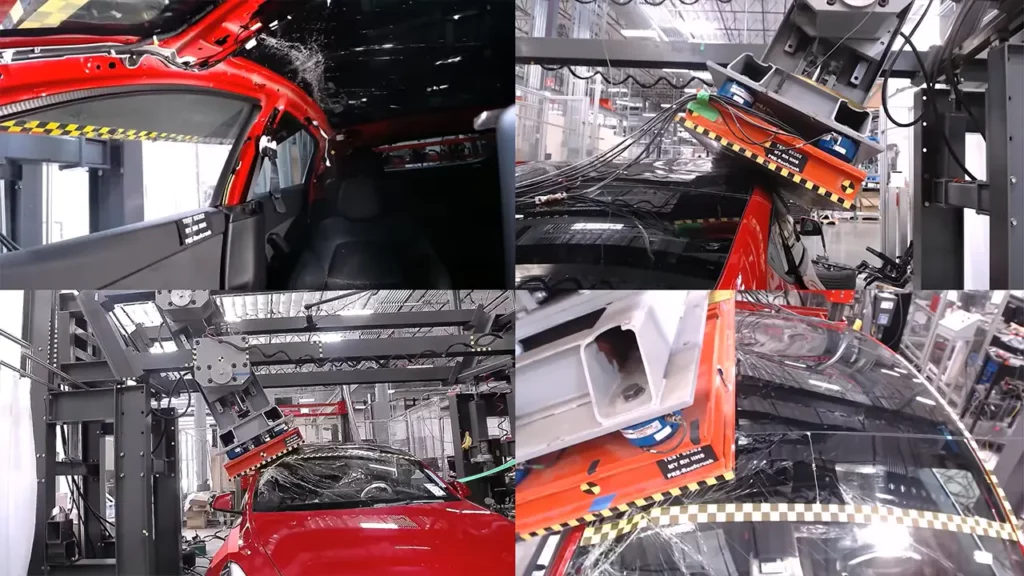In a new video recorded at the Tesla Design Center in Hawthorne, California, Tesla Glass Director Mike Pilliod explains how Tesla has made its vehicle glass tougher, quieter, and safer from ultraviolet exposure.
Mike demonstrated the acoustic insulation performance by sliding up his Model Y glass, the noise from outside suddenly dropped to almost zero. He also shared two design sketches of the Tesla Model Y (interior and exterior) that introduced the concept of the full glass roof from the front to the rear of the vehicle.

Turning this concept into reality took a large amount of R&D effort at the Tesla Glass Technologies Center, “We spent a ton of time making sure that each glass position is the right curvature, is the right size and shape in order to give that seamless approach,” Mike explained.

Laminated Double-Glass Side Windows
Since Tesla, Inc. practices constant improvement and innovation across the company, the Silicon Valley-based automaker improved its glass technology over the years. The new laminated double-glass side windows are now implemented in the entire lineup of vehicles. Tesla Model 3 received this upgrade with the 2021 Model 3 refresh.

Tesla has placed an acoustic dampening layer between the side window glass outer and inner layers that reduce road and wind noise during drive. Even when the vehicle is stationary, the outer sound pollution is minimized by this new technology.
Owners of older Tesla vehicles had complaints about the noisy cabin, especially the Model 3. But with this new technology, Tesla has taken care of this complaint. In addition to this, the 2021 Tesla Model S also has Active Noise Cancellation (ANC) to make the vehicle cabin feel even quieter.
UV Radiation Protection
The expansive glass roof is the specialty of all Tesla vehicles, to protect the occupants from heat and UV radiation of the sunlight, Tesla has implemented multiple layers of films in the glass.
Antonio, a glass specialist at Tesla explains in this video (below), that a 2% tint film is combined with other different types of films that reflect solar radiation. A PVB (Polyvinyl Butyral) film combines all of these layers to increase the toughness and flexibility of the roof glass implementations in other areas of a Tesla vehicle.

A Tesla roof absorbs 99% of UV radiation itself. This makes the cabin amazingly safe even though the occupants have a large open experience inside the vehicle.
Toughness
Tesla claims that the glass roof in its vehicles can withstand 4x the weight of the car. This has been practically demonstrated in several Tesla crashes we have seen over the years. Like a Tesla Model 3 rollover accident in China last year, the glass roof stayed intact despite the vehicle rolled multiple times.

Before putting the cars into production, Tesla extensively tests the toughness and safety of its proprietary glass with rollover and roof crush testing. After these tests, Tesla puts the glass through thermal tests, Mike further explains in this video.
Glimpse of the Giant Cybertruck Windshield Glass
Tesla also showed the giant Cybertruck windshield glass in this video for a few seconds. This must be one of the spare windscreens for the prototype Cybertruck that is under the use of Elon Musk usually.

Stay tuned for constant Tesla updates, follow us on:
Google News | Flipboard | X (Twitter) | WhatsApp Channel | RSS (Feedly).
Related Tesla News
- Here are the new dates for Tesla Robotaxi launch in Austin, Texas — first driverless Robotaxi spotted (videos)
- SpaceX prepares for Starship’s 10th flight, conducts a static fire test on Booster 16, Starbase updates
- Tesla offers 0% APR for Cybertruck orders with FSD (ends soon)
- Tesla (TSLA) teases upcoming 7-seat Model Y in new email to customers
- Trump to cancel SpaceX contracts, Musk retracts from decommissioning the Dragon spacecraft program
- Watch if a Tesla catches fire after falling off a cliff








